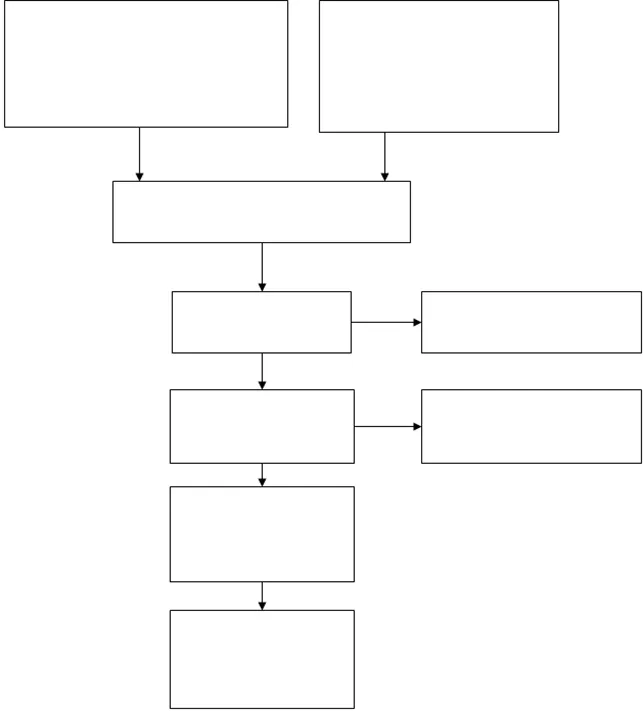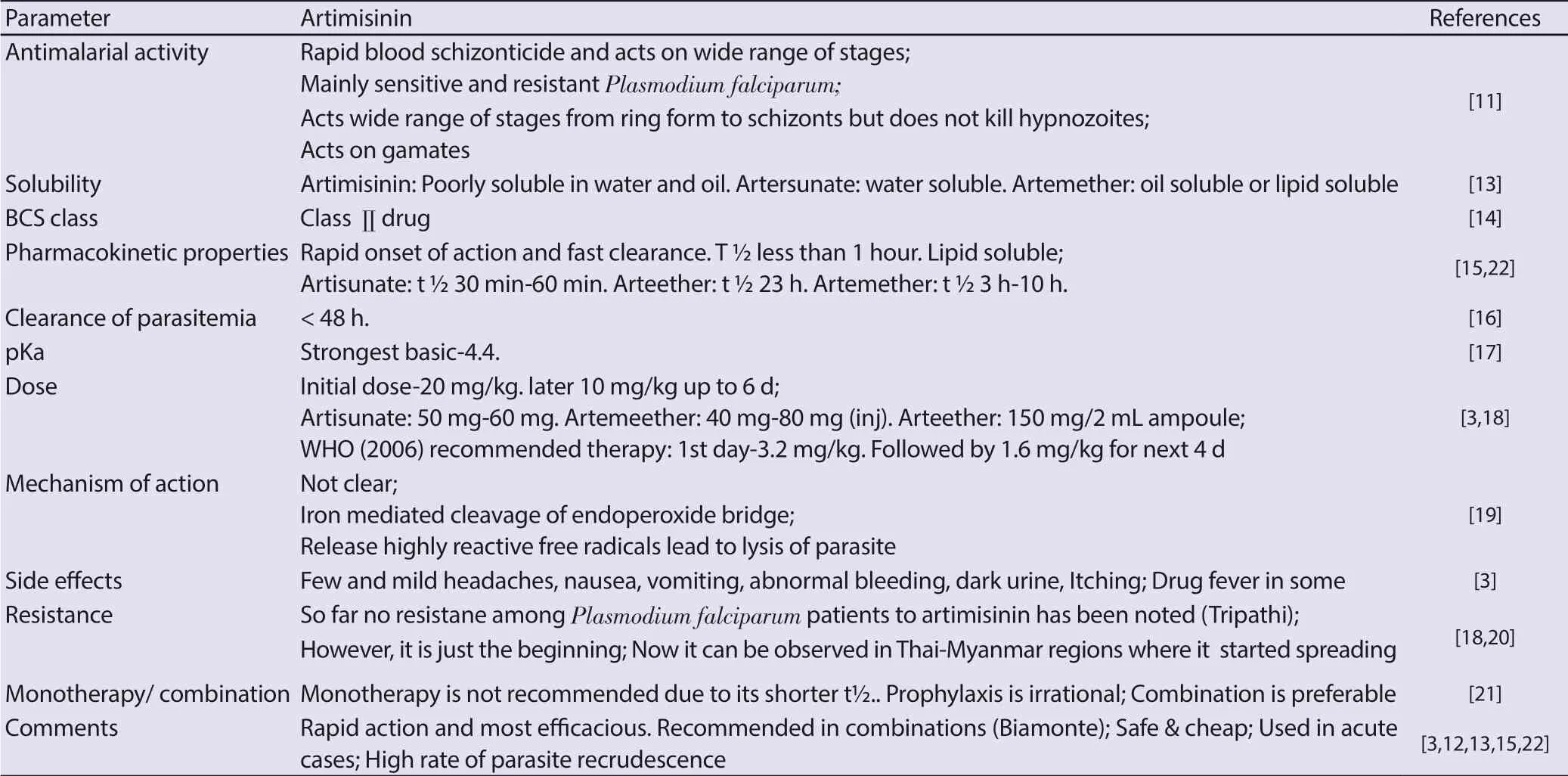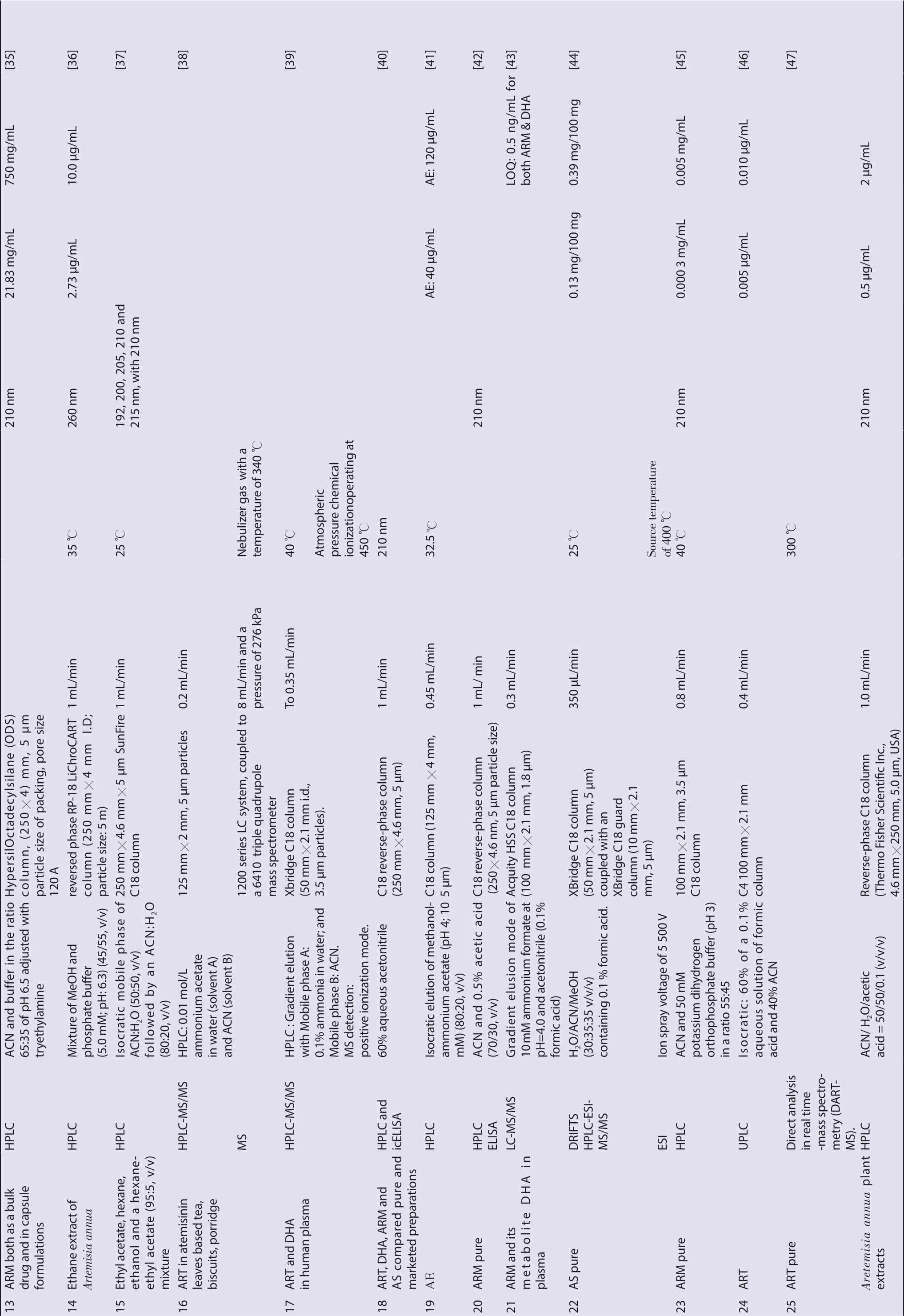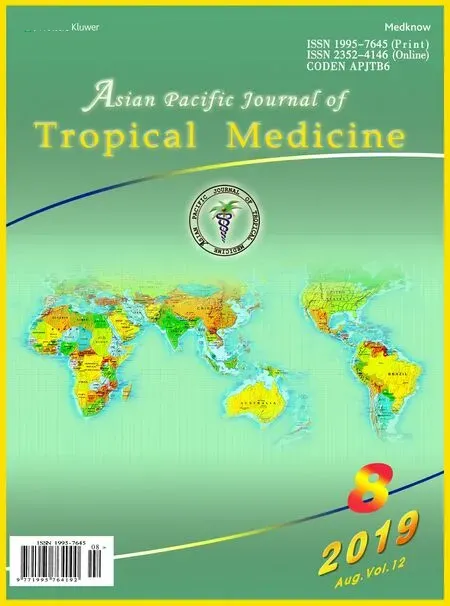Pharmacological and analytical aspects of artemisinin for malaria:Advances and challenges
Sravani Karri, Sanjay Sharma✉, Ginpreet Kaur
1NMIMS, School of Pharmacy and Technology Management, Shirpur, Maharashtra, India, 425405
2NMIMS, Shobhaben Pratapbhai Patel School of Pharmacy and Technology Management, Mumbai, Maharashtra, India, 400056
Keywords:Malaria Artemisinin Pharmacokinetics Mechanism Analytical techniques
ABSTRACT Malaria remains a major tropical health burden owing to the development of resistance and decreased sensitivity to the frequently used conventional antimalarial drugs. The drug like artemisinin possesses potent antimalarial activities, but has some limitations. Therefore, new strategies are to be implemented for optimal utilization of artemisinin to improve its therapeutic effectiveness and to overcome its limitations. The present review focuses on present scenario of malaria and pharmacological as well as analytical aspects of artemisinin. Data from 2000 to 2018 were collected from NCBI for understanding the various analytical techniques used for estimation of artemisinin. This review will reveal the facts about artemisinin which can be utilized to develop novel drug delivery system either in a combination or as alone for the wellbeing of the patients suffering from malaria.
1. Introduction
Malaria is one of the most serious tropical diseases, it requires therapeutic attention. Malaria stood a major global health complication with the high probability of development of resistance towards majority of conventional and frequently used anti-malarial agents. This problem is enhanced due to decreased ineffectiveness of drugs like chloroquine against Plasmodium (P.) vivax. The malaria is a protozoal disease mainly caused by four species of Plasmodium (P. falciparum, P. ovale, P. malaria, P. vivax) and other species like P. knowlesi, P. bhergie, etc. However, P. knowlesi and P. bhergieare are parasites which cause malaria in animals other than human beings. Whereas P. berghei is used as in-vivo antimalarial experimental model for the evaluation of anti-malarial activity of unknown test substances[1,2]. An Anopheles mosquito is the carrier for malarial parasite. When parasite enters in the human blood stream, it produces the symptoms like fever, chills, headache fatigue, nausea, vomiting, diarrhoea, occasionally coma and death may occur, etc[3]. The treatment of malaria is very essential but still there are many limitations and challenges in the management and control of malaria. Artemisinin is one of the widely used antimalarial drugs with good therapeutic potential against malaria.It is sesquiterpene lactone having endoperoxide group obtained from Chinese herb i.e. Artemisia (A.) annua. The present review highlighted the role of artemisinin in the management of malaria along with its pharmacological and analytical aspects. The literature selection flowchart is shown in Figure 1.
2. Epidemiology of malaria
According to the 11th World Malaria Report 2018 by World Health Organisation, the global malaria cases found in 2016 and 2017 are 217 and 219 million respectively[4,5]. In the year 2017, there were 435 000 deaths estimated from malaria globally. Children below 5 years were most affected by malaria to become the particularly vulnerable group across the world. About 266 000 deaths were observed, i.e. 61% of all malaria deaths worldwide from this age group[5,6]. Further, about 80% of deaths were recorded from 17 countries including African Region and India, of which, 7 countries accounted for 53% deaths around the world (Burkina Faso 6%,Democratic Republic of the Congo 11% , India 4%, Niger 4%,Nigeria 19 %, Sierra Leone 4%, United Republic of Tanzania 5%)[5,7,8]. These data indicated that malaria still requires a great attention.

Figure 1. The flowchart of the literature selection process.
3. Current challenges in the management of malaria
The present world is experiencing vulnerable effects of malaria and its complications. The epidemiology of malaria is increasing day by day. The treatment of malaria becomes a big task as it has many challenges. The examples of such challenges are, urban malaria,parasite’s drug resistance, malaria in pregnancy, resistance towards insecticides, etc[9]. The treatment was using current antimalarial drugs in combination with artemisinin and its derivatives as a‘partner’ drug. This strategy is known as artemisinin combination therapies and this is considered as the choice of treatment in malaria. But as per the recent reports, the resistance has been found to be developed to artemisinin as well as their derivatives. This raised the considerable concern in the utilization of artemisinin for the management of malaria. Therefore, the public health care policies re-focussed on maximising therapeutic effectiveness and reducing chances of development of resistance even on its long-term utilization for the treatment of malaria[10]. Hence, either new antimalarial drugs are to be evaluated or bio-enhancers should be used along with artemisinin so as to counteract its limitations.
4. Artemisininin
The Nobel Prize was won by Youyou Tu and other Chinese scientists (2015) in the field of physiology or medicine research for discovering artemisinin and its derivatives like artemether and artesunate. These anti-malarial drugs saved millions of people across the globe[11]. Artemisinin is derived from A. annua extracts.It is mainly used against highly drug resistant strains causing malaria. The recent reports have shown that artemisinin also has potent anticancer activity. Nevertheless, artemisinin is safe and less expensive, too[12] .
It is a huge scope in the development of various novel drug delivery systems and evaluation of further therapeutic potential of artemisinin and its derivatives. Certain facts associated with artemisinin are given in Table 1.
Artemsinin is natural molecule obtained from A. annua discovered in year 1967 by research conducted by the Chinese Academy of Medical Sciences in Beijing by Youyou Tu under the title Project 523[22]. It is one of the most potent drugs for the treatment of malaria which acts on both blood stage and liver stage schizonts, but rapidly affects blood schizonts. It is active against almost all species of Plasmodium including resistant P. falciparum. After administration of initial dose of 20 mg/kg, parasitemia can be cleared within 48 h.The pharmacodynamics aspects of the drug are not clear but the probable action of artemisinin towards the parasite may be due to the cleavage of endoperoxide bridge. This leads to release of highly reactive species of free radicals which damages parasite proteins and offers rapid killing. But complete clearance of this drug is slow because of its low half-life less than 1 hour due to certain points like low half-life, Biopharmaceutics Classification System(BCS) classⅡsolubility, slow clearance, recrudesce of parasitemia,low bio-availability, etc. Artemisinin is not recommended alone as monotherapy and its prophylaxis usage is irrational. All these mentioned advantages and limitations need to be considered while initiating the research associated with artemisinin so as to fulfil the related lacunas.
4.1. Mechanism of artemisinin action
The exact mechanism of artemisinin action is still debatable.The probable mechanism of action includes killing of parasite by releasing highly reactive free radicals responsible for lysis of parasite[19]. These carbon-centred free radicals were generated through heme-mediated decomposition of the endoperoxide bridge,which binds to the membrane proteins and lipid peroxidation takes place. This damages the endoplasmic reticulum and inhibits protein synthesis in parasite. It results in lysis of parasite and shows its antimalarial activity.

Table 1. Biopharmaceutic characteristics of artemisinin and its derivatives.
4.2. Analytical & bio-analytical methods used for artemisinin quantificationin research publications of NCBI from 2000 to 2018
Many analytical and bio-analytical methods used for artemisinin quantification (Method: Research publications in NCBI from 2000 to 2018) are summarized in Table 2. The abbreviations are listed here: methanol extracts of artemisinin (AM), arteannuin-B(AB), artemisinic acid (AA), hexane extraction of A. annua(AH), acetonitrile (ACN), artemisinin (ART), trifluoro acetic acid (TFA), artesunate (AS) , dihydroartemisinin (DHA), water H2O, petroleum ether-acetone extract of A. annua (APE-A),n-hexane extract of Artemsias spp. (AnH), artemether (AM),dihydroartemisininGlucoronide (DHA-G), Formic acid (FA),chloroform (CHCl3), hexane (H), ethyl acetate (EA), methyl alcohol (MeOH), artemether (ARM), formic acid (FA), triple stage quadrupole (TSQ), mass spectrometer (MS), β-arteether (AE), limit of detection (LOD), limit of quantification (LOQ).
Conventional and advanced chromatographic techniques like thin layer chromatography (TLC), Gas chromatography (GC), High Performance Liquid Chromatography (HPLC-UV), GC with flame ionization detection (GC-FID) have been used for quantification of artemisinin. HPLC with evaporative light scattering detector (HPLCELSD) was used in specific condition. Other than chromatographic techniques, icELISA-Indirect Competitive Enzyme linked immune sorbet assay and diffuse reflectance infrared Fourier transform spectroscopy (DRIFTS) were used for estimation of artemisinin in different matrices. Consequently, hyphened techniques HPLCESI-MS/MS-HPLC with electrospray (ESI) ion mass spectrometry,UPLC techniques and their corresponding methods have been applied in the analysis of artemisinin.
Chromatographic techniques are frequently used for determination of artemisinin and its metabolites dihydroartemisinin in the different matrices. Moreover, isocratic as well as gradient mode was used for quantitative analysis of artemisinin. Limit of detection and limit of quantification were significantly established. As per bioanalytical aspect, hyphened techniques like high-performance liquid chromatography/tandem mass spectrometry LCMS/MS were used for determination of artemisinin in biological fluid. The frequent utilization of chemicals, drug candidate and solvents in chromatographic methods in pharmaceutical products has become a challenge to green chemistry. In the determination of artemisinin in different matrices by chromatographic methods requiring toxic solvents like methanol, acetonitrile and buffer are used which are also the environmental polluents. Therefore, researchers should think about utilization green solvents in the estimation of artemisinin in pharmaceutical formulations.
5. Artemisinin resistance as a challenge
The artemisinin is under risk due to occurence of the resistance in P.falciparum parasites in the Southeast Asian countries[48]. The malaria is a deadly tropical disease affecting many countries. There are many challenges in the treatment of malaria, of which the resistance is one of the most vital challenges. The conventional drugs such as chloroquine, mefloquine, pyrimethamine, quinine, sulfadoxine, etc.became inactive or less active against the parasite P. falciparum due to resistance. Moreover, the malarial parasite developed resistance against the most potent antimalarial drug-artemisinin as well[49].This is a big challenge in front or the healthcare professionals in the management of malaria. However, artemisinin combination therapy is considered as the first-line therapy in the regions where artemisinin alone has developed the resistance, but this strategy also failed and did not worked more efficiently. Therefore, the death rate got increased in these areas. Thus the new combinations with artemisinin are under clinical trials so as to counteract this problem and minimise the morbidity as well as mortality in affected areas. The study reported that G625R as a probable mutation was responsible for artemisinin resistance along with R539T gene mutation. Previously reported mutation was kelch13 alteration. The exact evaluation of this newly reported mutation is still unclear.Though lumefantrine and artemether are recommended combination in northeast India, pyrimethamine plus sulfadoxine with artesunate combination is still used in other regions of India[50]. Moreover, in order to tackle the alarming artemisinin resistance in malaria, WHO issued its Global plan for artemisinin resistance containment (GPARC)and emergency response to artemisinin resistance in the Greater Mekong Subregion. The major objective of these plans are to control and then complete eradicate artemisinin resistance malaria across the globe[51]. Recently, Nobel Laureate Youyou Tu announced that her team has proposed solutions to the problem of artemisinin resistance,giving new proofs that artemisinin is still “the best weapon” against malaria[52]. Furthermore, the alarming rate of artemisinin resistance need extensive attention of researchers so as to get the solution for effective and prompt management of malaria across the world.
6. Future perspectives of artemisininin
As there are many complex limitations in the utilization of antimalarial drug in the treatment of malaria, it is very essential to discover either new anti-malarial agents or to modify the current therapeutic approaches. Moreover, the combination therapy especially with artemisinin using appropriate partner possessing antimalarial activity or bio-enhancing potential can be the best approach.The new drug discovery from natural/semisynthetic/synthetic origin with or without chemical modifications can make the things in favour of malarial patients therapeutically. Such chemical modifications can also be applicable to already existing anti-malarial agents. Consequently, the development of hybrid compounds, reevaluation of commercially available therapeutic agents that have been approved for clinical utilization for any other morbidity and advanced molecular modelling by docking studies and virtual screening technology may play an important role. Nevertheless,finding a potent and appropriate bio-enhancer for artemisinin can also make remarkable significance in the therapeutic management of malaria[1]. Using these strategies and suitable approaches with specificity against malarial parasites optimum control can be achieved on tropical diseases like malaria.

Table 2. Analytical & bio-analytical methods used for artemisinin.

Table 2. Analytical & bio-analytical methods used for artemisinin (continued).
Conflict of interest statement
We declare that we have no conflict of interest.
 Asian Pacific Journal of Tropical Medicine2019年8期
Asian Pacific Journal of Tropical Medicine2019年8期
- Asian Pacific Journal of Tropical Medicine的其它文章
- Chlamydoconidium-producing Trichophyton tonsurans: Atypical morphological features of strains causing tinea capitis in Ceará, Brazil
- Molecular identification of hemoplasmas in free ranging non-human primates in Thailand
- Tioxolone niosomes exert antileishmanial effects on Leishmania tropica by promoting promastigote apoptosis and immunomodulation
- Evaluation of in vitro and in vivo immunostimulatory activities of poly (lactic-co-glycolic acid) nanoparticles loaded with soluble and autoclaved Leishmania infantum antigens: A novel vaccine candidate against visceral leishmaniasis
- The cholera epidemic of 2004 in Douala, Cameroon: A lesson learned
